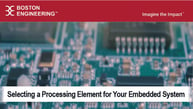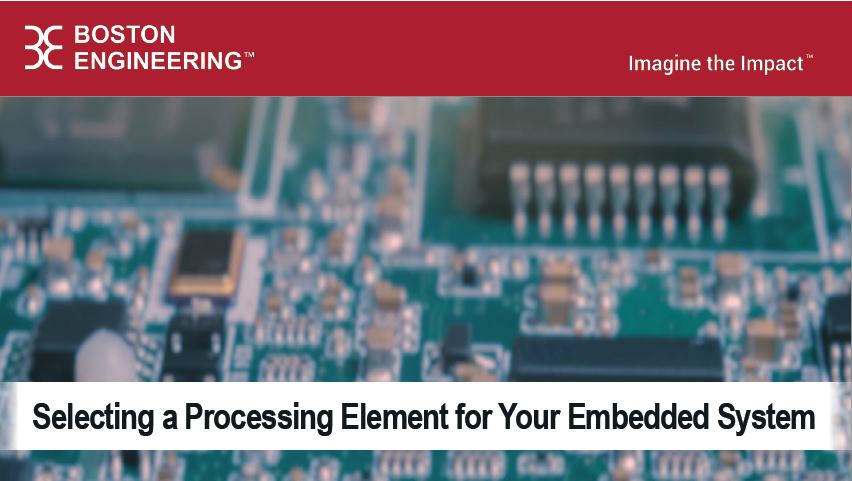The Approach to Take when Selecting a Processing Element for Your Embedded System
 This article is an excerpt from the Boston Engineering "Selecting a Processing Element for Your Embedded System" white paper. For a copy of the the complete publication, visit the Selecting a Processing Element for Your Embedded System download page.
This article is an excerpt from the Boston Engineering "Selecting a Processing Element for Your Embedded System" white paper. For a copy of the the complete publication, visit the Selecting a Processing Element for Your Embedded System download page.
3. Approach to Take:
The architectural block diagram and any associated analysis should lead to an understanding of the real time performance, data rates and memory requirements of the system. For instance, a multi-channel high fidelity data acquisition system with MHz bandwidth per channel and a bunch of signal processing on each channel responding in a few 10s of microseconds screams FPGA or specialized processor (DSP). On the other hand, an embedded system with a few simple I/O’s, several sensors and an LED’s or two that talks Bluetooth Low Energy (BLE) can be realized with a small low-cost microcontroller.
Many embedded systems fit into categories that have developed their own technologies and architectures that can be leveraged. Robotics is just such a category, and the Robot Operating System (ROS2) is just such technology. ROS2 is an open-source development kit that runs on top of Linux and provides a distributed computing architecture and a wealth of robotics focused libraries and algorithms.
Embrace the future trends that are shaping a new era of engineering excellence.
Boston Engineering is a multidisciplinary engineering consulting firm that is often faced with the task of selecting a processing element (MCU, MPU, Single board computer, FPGA, SoC, or SoM) for an embedded system. This can be a simple or complicated task based on the project. Fortunately, one can take the same steps to select the processing elements for most embedded systems.
Download for groundbreaking insights!
Once the team selects ROS2 the decision of a processing element is naturally focused on a processor that runs Linux, has enough capability to run complex algorithms while meeting the remining requirements. Boston Engineering has successful chosen SoMs for ROS2 applications. We have also placed Micro ROS on Microcontrollers. This allows a ROS2 variant to run on smaller, lower cost embedded systems.
A single or a few requirements can drive the selection of the embedded processor. In other cases, the application itself can push the decision toward a group of processors. For instance, and application involving motor controllers and/or digital signal processing points toward a specialty processor. Specialty processors are increasingly being targeted in power electronics applications.
For a copy of the the complete publication, visit the Selecting a Processing Element for Your Embedded System download page.
.png?width=760&height=133&name=Surgical%20Robotics%20(1).png)
As the engineering landscape continues to evolve, Boston Engineering is committed to proactively integrating cutting-edge technologies and methodologies into the solutions it delivers, ensuring that clients stay at the forefront of industry trends and maintain a competitive edge.
About the Authors
Aaron Pailes
Sr. Principal Systems Engineer, Boston Engineering
Aaron is a skilled and versatile engineer with a strong background in systems and design engineering. He has contributed significantly to various technological advancements, including side scan sonar platforms, innovative sonar nadir filling technology, security scanners, network monitoring equipment, and RADAR systems
Kathryn Stringer
Electrical Engineer, Boston Engineering
Kathryn designs diverse electrical prototypes for medical/defense sectors, adept in PCB design, testing, and rapid breadboard creation. She collaborates on custom electronics for medical devices and ROV applications.
Tanner Jameson
Electrical Engineer, Boston Engineering
Tanner is a Tufts University graduate, specializing in collaborative circuitry design, software and hardware integration, and product prototyping.
Ready to learn more about Boston Engineering?
For almost three decades, Boston Engineering has designed, developed, and optimized devices and technologies the medical, Commercial, and Defense communities rely on to improve the way people work and live. We provide solutions to the challenges society faces.
Our expertise includes industrial design and product redesign, sensors and control systems, robotics technical innovation, and digital software solutions.
Imagine your Impact: Stay up-to-date with the latest insights and trends we're watching. Add your email address below and sign up for a monthly summary of our most impactful posts!











